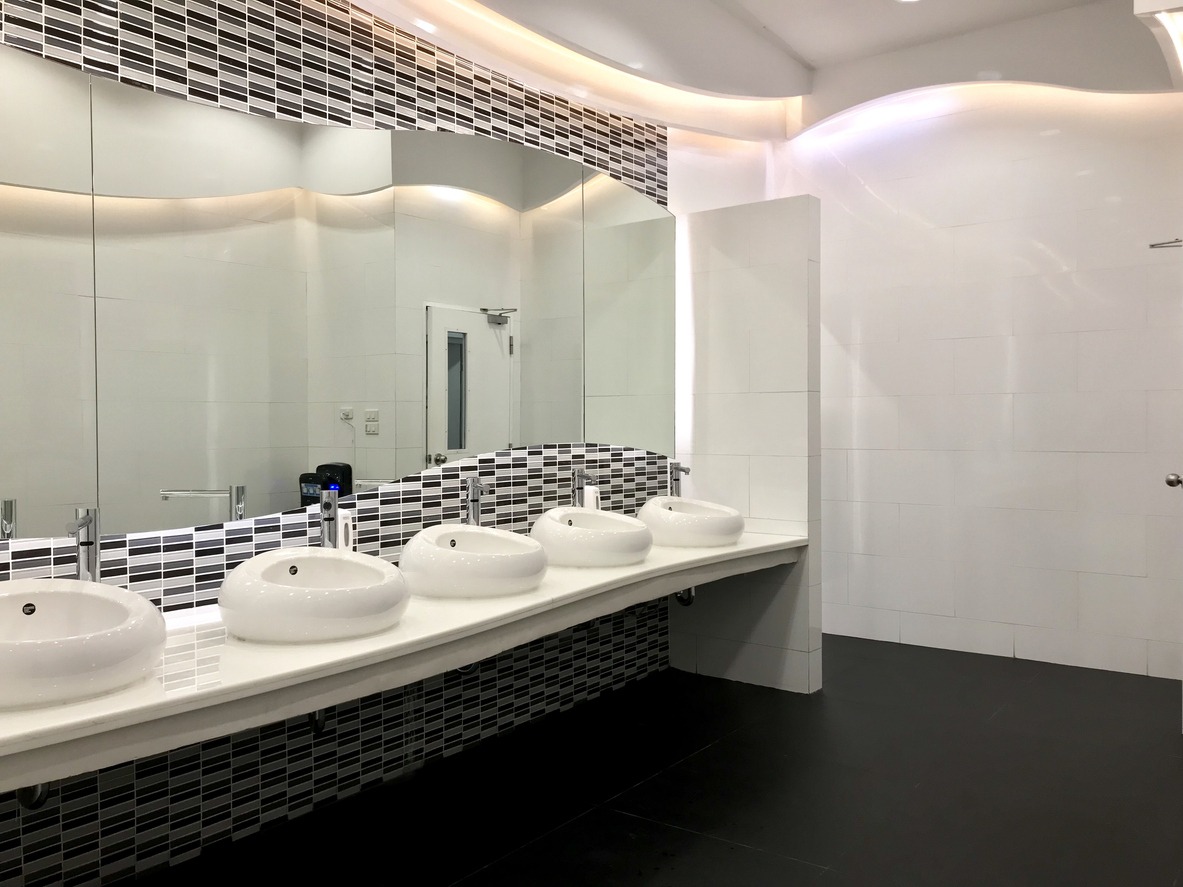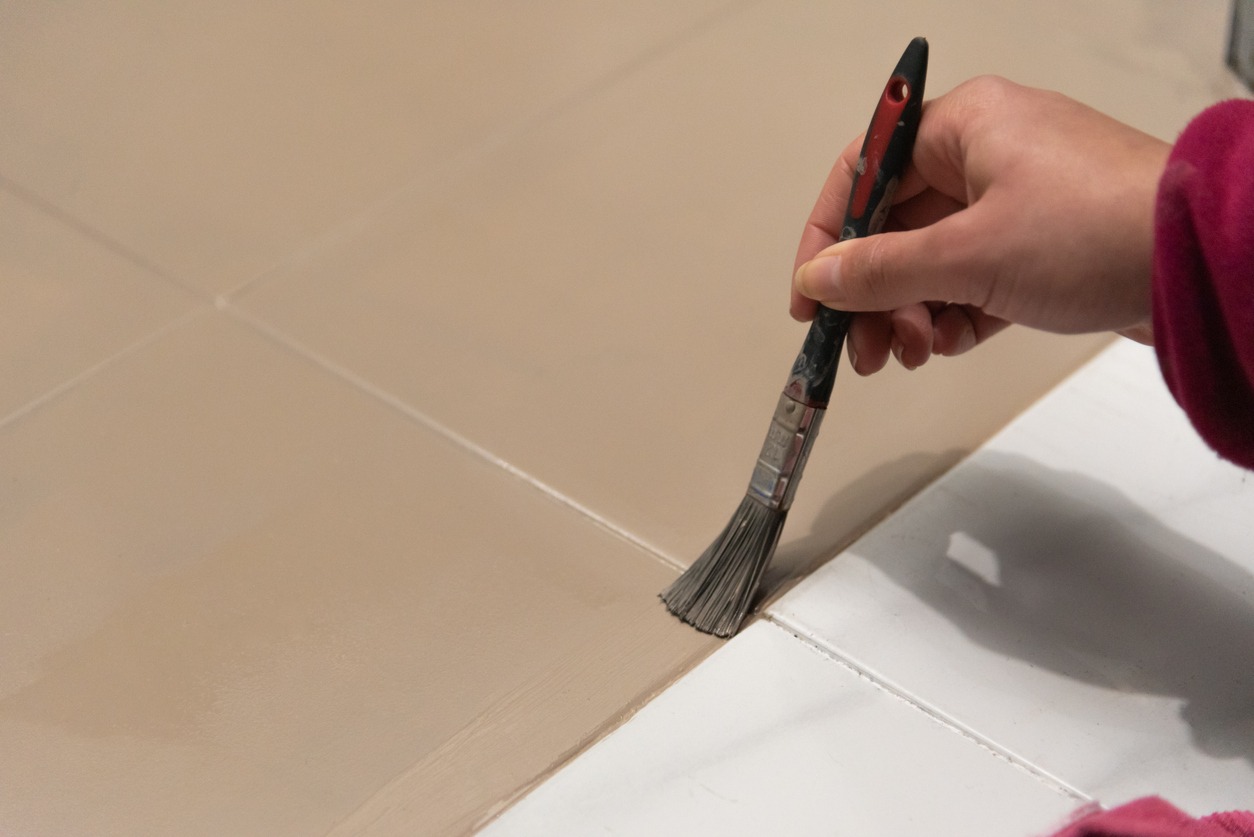Selecting the right type of paint for commercial building bathrooms is essential for maintaining a clean and professional appearance. The paint must withstand high humidity, frequent cleaning, and heavy use. The choice of paint affects the overall aesthetic and maintenance costs of the bathrooms. Join us as we talk about the key considerations for selecting the best paint for these unique spaces.
Why Should You Paint Bathrooms?
Painting commercial bathrooms has more benefits than just being an aesthetic choice. It provides practical benefits that enhance the functionality and appearance of these spaces. Here are the reasons why painting commercial bathrooms is important:
- Improved Hygiene: Fresh paint helps create a clean and sanitary environment, making it easier to maintain cleanliness and hygiene standards.
- Durability: The right paint can protect walls from moisture damage, preventing mold and mildew growth and prolonging the lifespan of the bathroom surfaces.
- Aesthetic Appeal: A well-painted bathroom creates a welcoming and professional atmosphere, which is essential for customer and employee satisfaction.
- Cost-Effective Maintenance: Regularly painting bathrooms can help reduce maintenance costs by protecting surfaces from wear and tear. Less maintenance also means minimizing the need for repairs.
- Compliance with Regulations: Certain commercial buildings must meet specific health and safety regulations, which often include maintaining clean and well-maintained restroom facilities.
Paint vs Tiles for Bathrooms
When deciding between paint and tiles for bathrooms, there are several factors to consider. Each option offers distinct advantages and disadvantages. Here’s a breakdown of the main factors to help you make the best choice for your bathroom.
Cost
Paint is generally more affordable than tiles, both in terms of materials and installation. Painting a bathroom requires less time and labor, making it a cost-effective option for many. Tiles may have a higher upfront cost, but they can offer long-term savings due to their durability and low maintenance.
Maintenance
Painted walls are easier to refresh and touch up when needed, making them a practical choice for spaces that may require frequent updates.
On the other hand, tiles are more resistant to water and stains, making them easier to clean and maintain over time. While grout lines may require periodic cleaning, the overall maintenance for tiled surfaces is generally low.
Aesthetic Flexibility
Paint provides a wide range of color options and finishes, allowing for more customization in the bathroom’s design. It also offers the flexibility to change the color scheme easily if desired.
Tiles offer various styles and patterns, adding texture and character to the space. However, once tiles are installed, changing the design is more challenging and often requires a complete renovation. Fortunately, you have the choice of painting over tiles, although the adhesiveness of the paint would depend on the type of tile you installed.
You can also make the building’s bathroom align with your brand’s identity, as you can incorporate the colors commonly used for your brand’s logo.
Durability
While high-quality paint can withstand moisture and wear, tiles are typically more durable and resistant to damage. Tiles can handle heavy use and are less likely to show signs of wear over time. This durability makes them an ideal choice for high-traffic bathrooms where long-lasting materials are needed.
The Types of Paint Commonly Used for Bathrooms
Making a decision on the right type of paint to choose for bathrooms is essential so that the said areas of the commercial building can withstand moisture and frequent cleaning. Different paints offer various benefits, depending on the specific needs of the space. Here’s a look at the types of paint commonly used for bathrooms.
Semi-Gloss Paint
Semi-gloss paint is a popular choice for bathrooms due to its durability and resistance to moisture. Its shiny finish repels water and makes it easy to wipe down, which is essential in a bathroom environment. This type of paint also stands up well to frequent cleaning without losing its sheen.
Additionally, semi-gloss paint can help brighten up a bathroom by reflecting light, making the space appear larger and more open. It is ideal for high-traffic areas where durability and easy maintenance are priorities. However, it may highlight imperfections on the walls, so proper surface preparation is key.
Satin Paint
Satin paint offers a smooth, low-luster finish that provides a more subtle shine compared to semi-gloss. It is moisture-resistant, making it suitable for bathrooms, and it is easier to clean than flat or matte finishes. Satin paint is a good option for those who want a balance between durability and aesthetic appeal.
This type of paint can conceal minor wall imperfections better than semi-gloss while still offering some light reflection. It is versatile and can be used on walls, trim, and even ceilings. Satin paint is a practical choice for homeowners looking for a durable yet attractive finish.
Eggshell Paint
Eggshell paint has a low-sheen finish that is less reflective than satin and semi-gloss paints. It offers a subtle, soft look, making it a good choice for bathroom walls where a more muted appearance is desired. While it is not as moisture-resistant as higher-sheen paints, it still offers decent protection in less humid bathroom areas.
Cleaning eggshell paint requires a gentle touch, as it is not as durable as semi-gloss or satin. It is best suited for bathrooms with adequate ventilation and lower humidity levels. Despite its limitations, eggshell paint can create a warm, inviting atmosphere in the bathroom.
Selecting the Right Type of Paint for Commercial Building Bathrooms
The choice of the right paint for commercial building bathrooms involves more than just picking a color. The paint must withstand moisture, frequent cleaning, and heavy use. Below are some tips to help you select the best paint for these spaces.
Consider Durability
Durability is a key factor when selecting paint for commercial bathrooms. High-traffic areas require paints that can withstand wear and tear, as well as frequent cleaning. Semi-gloss or satin finishes are ideal as they are durable and resistant to moisture. These finishes also make it easier to clean surfaces without damaging the paint.
Investing in high-quality, durable paint can save money in the long run by reducing the need for frequent repaints. It also helps maintain a professional appearance, which is important for customer satisfaction. Choose paints that specifically mention durability and resistance to moisture on the label.
Prioritize Moisture Resistance
Bathrooms are naturally humid environments, making moisture resistance an essential consideration. Choose paints designed to resist moisture, as they help prevent mold and mildew growth. Paints with anti-microbial additives can provide additional protection against these issues.
Moisture-resistant paints also help maintain the integrity of the walls, preventing peeling and bubbling. This is especially important in commercial settings where maintenance is less frequent. Look for paints labeled as bathroom or kitchen-specific, as these are formulated to handle high moisture levels.
Focus on Ease of Maintenance
Commercial bathrooms require easy-to-maintain surfaces due to high usage. Choose paints that can be easily wiped clean without losing their finish. Semi-gloss and satin finishes are generally more washable than matte or eggshell finishes, making them practical choices for these areas.
Easy maintenance not only keeps the bathroom looking clean but also helps in adhering to health and safety standards. Consider the cleaning protocols for your building and select a paint that can handle the cleaning agents used. This will help in maintaining a hygienic environment with minimal effort.
Choosing Colors for Commercial Building Bathrooms
The best colors for commercial building bathrooms can affect the overall atmosphere and user experience positively. The color scheme should be practical and align with the business’s brand and design. Check out these tips to guide you in selecting the best colors for these spaces:
- Consider the Size of the Space: Light colors can make small bathrooms feel larger and more open, while darker shades may create a cozier, more intimate environment. Choose colors that enhance the size and feel of the bathroom.
- Focus on Clean and Inviting Tones: Neutral colors like whites, grays, and beiges are popular choices as they convey cleanliness and simplicity. These shades also complement a wide range of fixtures and finishes, making them versatile.
- Reflect Brand Identity: If the building houses a specific business, consider incorporating brand colors into the bathroom design. This creates a cohesive look and reinforces brand identity throughout the facility. So, if your brand uses the colors red and blue, you will need to make sure that you are using those colors for the paint you will be applying to the bathroom. The same philosophy can also be applied to other areas of the building.
- Prioritize Durability and Maintenance: Opt for colors that are practical and easy to maintain. Darker colors might hide stains and wear better over time, while lighter shades may show dirt more easily but provide a brighter, cleaner look.
- Add Accents for Interest: Using accent colors can add visual interest without overwhelming the space. Consider a feature wall or trim in a contrasting color to add a touch of style. This approach allows for flexibility if you want to update the look of the bathroom later.
- Think About Lighting: The type and amount of lighting in the bathroom can affect how colors appear. Test paint samples in the actual space to see how they look under the existing lighting conditions before making a final decision.
Applying Paint on Commercial Building Bathrooms
Applying paint to commercial building bathrooms requires careful preparation and execution to achieve the best results. Here are the essential steps to follow.
Preparation and Cleaning
Proper preparation is crucial before applying paint. Start by removing any fixtures, such as mirrors and towel racks, to provide unobstructed access to the walls. Clean the walls thoroughly to remove dirt, grease, and any mold or mildew. Use a mild detergent or a mixture of water and bleach for cleaning, and let the surfaces dry completely.
Sanding the walls is also necessary to smooth out any rough areas and create a surface that allows the paint to adhere better. Patch any holes or cracks with a suitable filler, and sand them down once dry. Masking off areas like trim, fixtures, and floors with painter’s tape will protect them from paint splatters and provide clean edges.
Priming the Walls
Priming is an essential step in the painting process, especially in bathrooms where moisture can be a concern. Apply a high-quality primer that is designed for use in humid environments. Primers help seal the surface, providing a better base for the topcoat and enhancing paint adhesion. They also prevent stains from bleeding through the paint.
Allow the primer to dry according to the manufacturer’s instructions, usually for a few hours. This step not only prepares the surface for paint but also helps in covering any existing colors or stains. Priming is particularly important when painting over dark colors or new drywall, as it ensures even coverage and a uniform finish.
Applying the Paint
Once the primer is dry, you can start applying the paint. Use a high-quality roller for large wall areas and a brush for cutting in around edges and corners. For commercial bathrooms, it is recommended to apply at least two coats of paint. The first coat should be applied evenly and allowed to dry completely before applying the second coat.
Between coats, lightly sand the surface to remove any imperfections and ensure a smooth finish. Be mindful of the drying times between coats, as rushing this process can affect the final outcome.
Proper ventilation during painting helps speed up drying and reduces exposure to paint fumes. After the final coat, allow the paint to cure fully before reinstalling fixtures and using the bathroom.
Conclusion
Choosing the right type of paint for commercial building bathrooms is essential for maintaining a clean, professional, and durable space. The correct paint type can help enhance the bathroom’s appearance while ensuring it stands up to high traffic, moisture, and frequent cleaning. It’s important to select a paint that offers both aesthetic appeal and practical benefits, whether you are opting for semi-gloss, satin, or another finish.
For professional painting services, contact Custom Painting, Inc. at 925-294-8062 or fill out a Contact Form on our website. We are ready to help with your commercial bathroom painting needs.



